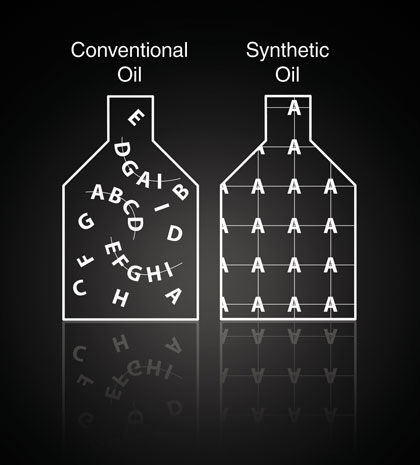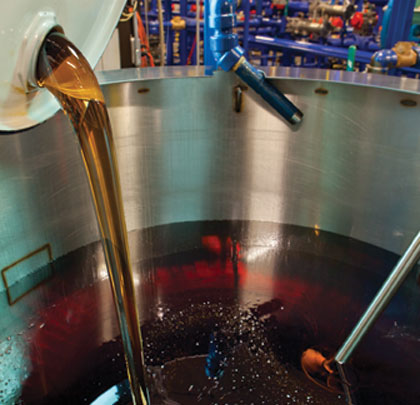Getting the right motor oil and the best value both play a role in managing preventive maintenance and expenses. Wading through the combination of marketing spin, specifications, and technical information can make understanding which product to use and finding the best value in motor oil a challenge. The following is a breakdown of motor oil basics.
VISCOSITY AND OIL WEIGHTS
Viscosity is a fluid’s resistance to flow. A higher viscosity fluid like honey takes longer to flow than a lower viscosity fluid like water. As the temperature rises, oil viscosity drops and the oil thins.
When additives are introduced to base oils, they enable a single oil to behave like a thinner oil (low viscosity) in cold temperatures and a thicker oil (higher viscosity) in warmer temperatures; hence the name multi-viscosity oil.
The Society of Automotive Engineers (SAE) and American Petroleum Institute (API) provide industry standards for measuring oil viscosity. An oil with an SAE viscosity grade 5W-40 behaves like a 5W oil at low temperatures (the “W” stands for winter) and a 40 at higher temperatures.
In general, in a given engine at operating temperature a 5W-40 and a 15W-40 have the same viscosity; one will not be “thinner” or have a lower viscosity than the other. Both will have a viscosity of a 40 grade. That cannot be said for both oils during the dead of winter. The 5W-40 will have a lower viscosity when the engine is started than the 15W-40; consequently the 5W-40 will start easier and lubricate quicker in the cold than the 15W-40.
SPECIFICATIONS AND SYMBOLS
The American Petroleum Institute (API) defines minimum lubrication requirements for motor oil physical properties and performance. Only lubricants that meet the API requirements and are licensed by the API are allowed to use the API Service Symbol, which looks like a doughnut and usually appears on the back label of most packaged lubricants or on drum labels:
- The top half describes the oil’s performance level.
- The center identifies the oil’s viscosity.
- The bottom half tells whether the oil has demonstrated energy-conserving properties in a standard test.
There are different API categories for diesel and gasoline fueled engines. Diesel engines require a “C” designation, which means compression ignition, and the latest category CJ-4 was introduced in 2006 for 2007 compliant on-highway exhaust emission standards. New emission standards for off-road equipment followed shortly thereafter, and CJ-4 standard covered these requirements as well. CJ-4 is backwards compatible, and covers most all diesel engines currently in use.

CONVENTIONAL VS. SYNTHETICS
Motor oil, whether synthetic or petroleum-based, consists of molecular chains of hydrogen and carbon atoms, referred to as hydrocarbons. Petroleum crude oil is a thick, flammable dark-brown or greenish liquid. Many contaminating elements exist in this complex mixture of hydrocarbons, including sulfur, nitrogen, oxygen, and metal components, such as nickel. The oil refining process separates the various types of molecules, and removes the undesirable elements. The resulting products include gasoline, liquid petroleum gas, and kerosene or lubricant base oils. The chemical composition of conventional motor oil can vary substantially depending on the raw crude oil refining process.
While petroleum base oils are refined, synthetic oil is chemically engineered or manufactured for a certain molecular composition with a tailored and uniform structure. Such fine-tuned control over the final molecular composition of synthetic oils is the key to their superior performance properties. Designing molecular structures in a planned and orderly fashion results in molecules, and end-products that are far more stable than their refined petroleum counterparts.
Advantages of synthetics include lower deposit formation, wider operating temperatures, improved wear protection, good shear stability, and predictable, consistent properties.
Contractors today have more access to information and more choice in in their lubricant products and services than ever before. Getting a handle on the basics of motor oil can help contractors make the most of these choices and get the best value for their business. ■
About the Author Andy Arendt is the director technical marketing with AMSOIL INC. He can be reached at 715.392.7101, or aarendt@amsoil.com
Modern Contractor Solutions, August 2014
Did you enjoy this article?
Subscribe to the FREE Digital Edition of Modern Contractor Solutions Magazine!



